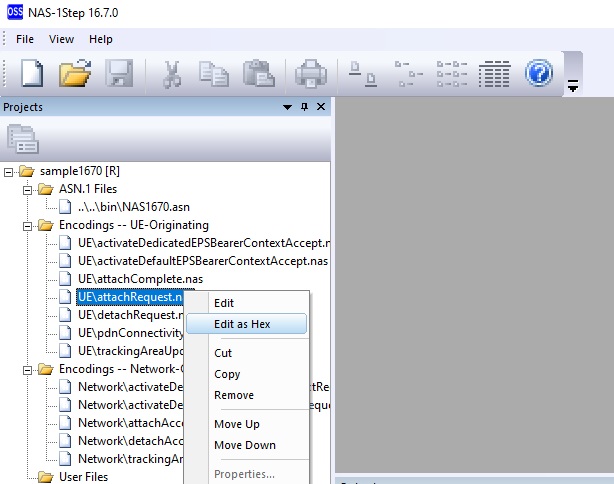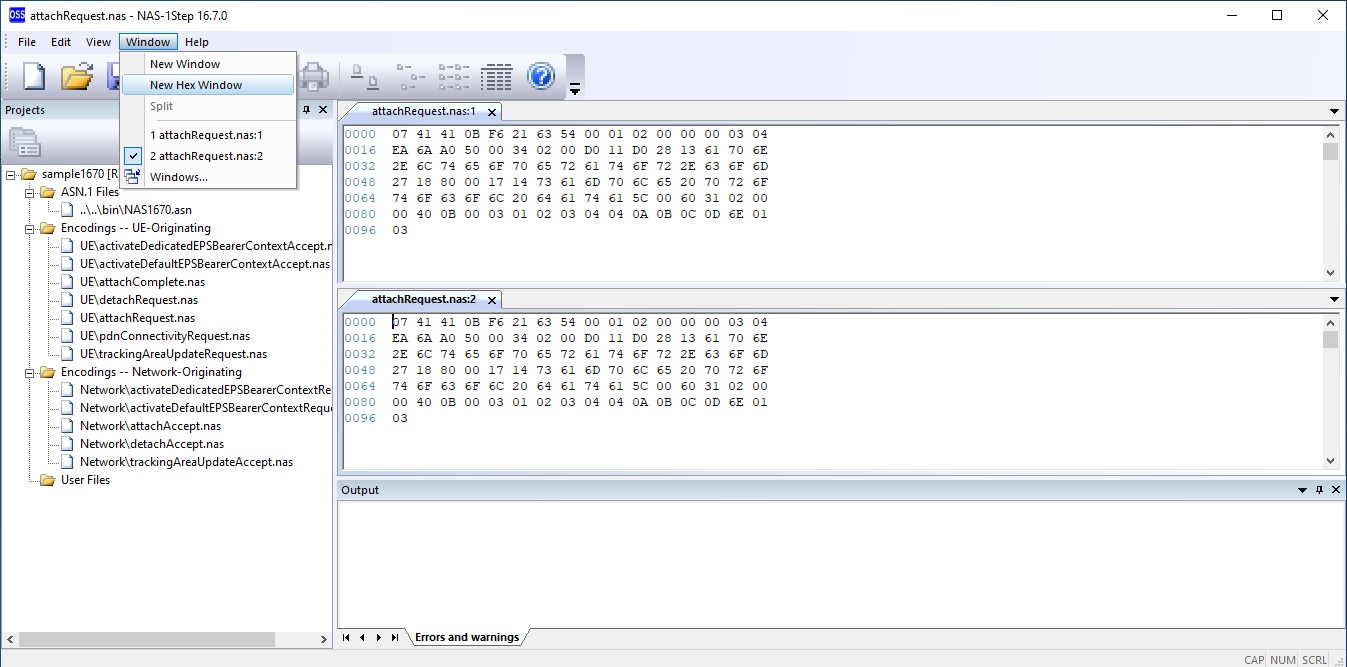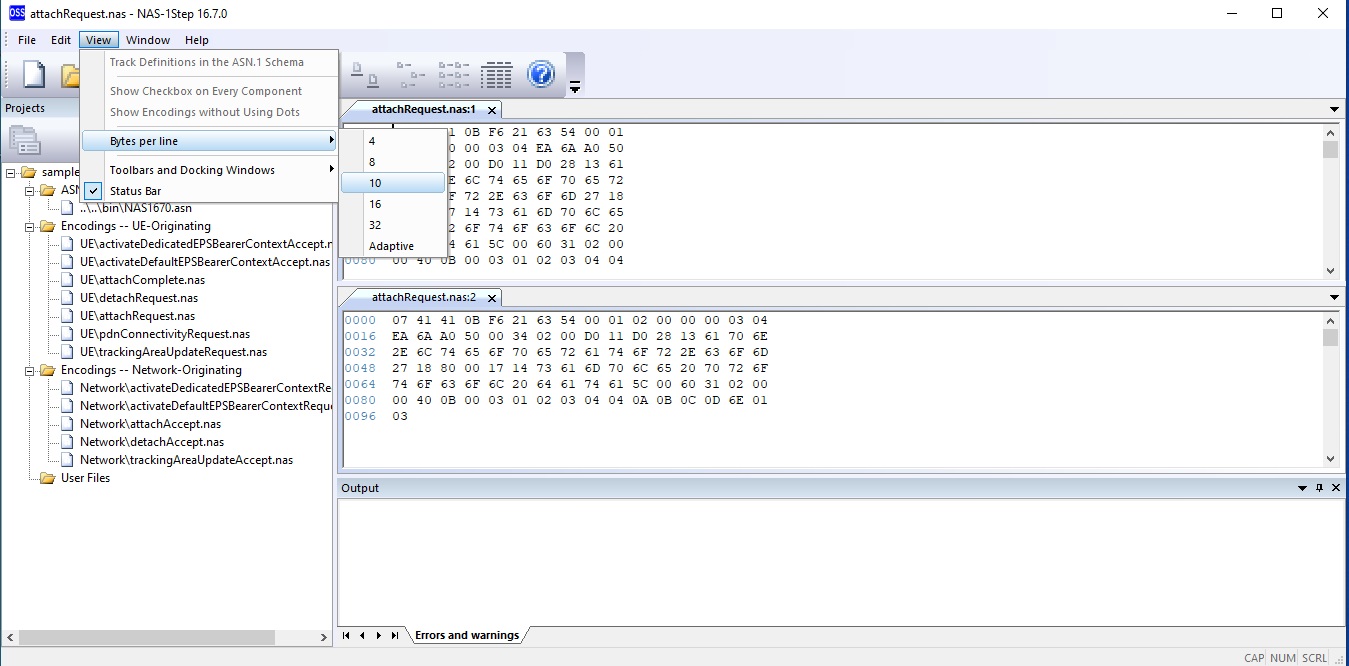 |
Projects Pane |
ASN.1 Schema Viewer |
Message Viewer/Editor |
Hex Viewer/Editor |
Output Pane |
Command-Line Invocation
|
Projects Pane |
ASN.1 Schema Viewer |
Message Viewer/Editor |
Hex Viewer/Editor |
Output Pane |
Command-Line Invocation
Contents
To open a message in the hex viewer/editor, select an encoded message file in the projects pane and issue the Edit as Hex context menu command.

In addition, when the active window is a message viewer/editor or hex viewer/editor window, you can open a new hex viewer/editor window on the same underlying message by issuing the Window / New Hex Window main menu command. When multiple views are open on the same message, any changes you make in one of these views are immediately reflected in the other views.

The hex viewer/editor displays the contents of an encoded message. Each line in the hex view displays the same number of bytes, which is either a fixed number (4, 8, 10, 16, or 32) or Adaptive (the maximum number of bytes that fit in the width of the window at any time). This number can be changed by issuing the View / Bytes per Line main menu command. The leftmost column in each line contains the offset (in decimal notation) of the first byte of the line.

Within the hex view, all the basic editing operations such as entering text, selecting text, copying, pasting, cutting, deleting, and so on, work as expected for a Windows application, except that most editing operations work with entire bytes (the two digits of a byte plus the surrounding space), not with individual digits. The Insert key acts as a toggle for the insert/overwrite mode, which is initially set to insert.
At any time, the selection in the hex view is either empty or consists of a series of consecutive bytes. When you issue the Copy command (Ctrl+C), the contents of the selection are copied to the system clipboard as a string of text in hexadecimal format. The string consists entirely of uppercase hexadecimal digits and spaces (ASCII 32). You can then paste this string into any application that accepts plain text or hexadecimal strings.
When you select the entire contents of the hex view (e.g., by using Ctrl+A) and then issue the Copy command (Ctrl+C), the hexadecimal string that is copied to the clipboard will represent an entire NAS message. When you use an application that can import a NAS message encoded as hexadecimal strings through the clipboard, you can pass the message to that application by pasting into it.
Likewise, when you use an application that can export a NAS message by copying a hexadecimal string to the clipboard, you can then paste the hexadecimal string directly into the hex viewer/editor. Before you issue the Paste (Ctrl+V) command in the hex view, remember to either clear the hex view or to select all contents (Ctrl+A).
When you open both a message viewer/editor and a hex viewer/editor on the same message, then every time you click or press Enter on a field in the message viewer/editor, the hexadecimal digits in the hex viewer/editor that correspond to that field are displayed in red.
The portion of the hexadecimal text that is displayed in red is a continuous range and consists of an integral number of hexadecimal digits, not necessarily an integral number of bytes. When the field of interest is shorter than four bits or its boundaries are not aligned to 4-bit boundaries, each hexadecimal digit that contains one or more bits of the field is displayed in red.
![]()
When you move the cursor across the hex view, change the selection, or issue a Copy command, the red highlight is not affected. However, when you make a change to the hexadecimal text, the NAS message is decoded and the red highlight is lost.
| Menu item | Shortcut key | Description |
|---|---|---|
| File / Close | Closes the encoded message and all the message view/editor and hex viewer/editor windows that display it. If the message has been modified since the last time it was opened or saved, the application saves the encoded message after asking for and receiving permission from the user. | |
| File / Close All | Closes all the open files. If there are any open files that have been modified since the last time they were opened or saved, the application saves each of them after asking for and receiving permission from the user. | |
| File / Save | Ctrl+S | Saves the encoded message without closing the hex viewer/editor window. |
| File / Save As... | Displays a Save As dialog box that allows you to save the message file under a new name or as an XML-encoded or JSON-encoded message. No other files are saved. | |
| File / Save All | Saves all the open files that have been modified since the last time they were opened or saved. This also applies to message files. | |
| File / Exit | Terminates the application. If there are any open files that have been modified since the last time they were opened or saved, the application saves each of them after asking for and receiving permission from the user. | |
| Edit / Undo | Ctrl+Z | Discards the latest change made to the value of the current message that is not yet undone. |
| Edit / Redo | Ctrl+Y | When issued after one or more Undo commands, reapplies the latest change undone and not yet redone. |
| Edit / Cut | Ctrl+X | Deletes the bytes inside the current selection and copies them to the clipboard. |
| Edit / Copy | Ctrl+C | Copies the bytes inside the current selection to the clipboard. |
| Edit / Paste | Ctrl+V | Pastes the contents of the clipboard into the current selection, replacing the contents of the current selection if it is not empty (only if the clipboard contains a hexadecimal string). |
| Edit / Delete | Delete | Deletes the bytes in the current selection. |
| Edit / Insert | Insert | Toggles the insert/overwrite mode. |
| View / Bytes per Line | Changes the number of bytes displayed in each line of the hex view. This can be set either to a fixed number (4, 8, 10, 16, or 32) or to Adaptive (the maximum number of bytes that fit in the width of the window at any time). | |
| Window / New Window | Creates a message viewer/editor window that displays the same message that is displayed in the current hex viewer/editor window. | |
| Window / New Hex Window | Creates another hex viewer/editor window that displays the same message that is displayed in the current hex viewer/editor window. | |
| Window / Split | Splits the hex viewer/editor window vertically into two panes, if the window is not already split. After the split, each pane will contain a hex viewer/editor and both will display the same message. |
| Menu item | Shortcut key | Description |
|---|---|---|
| New Vertical Tab Group | Creates a new tab group to the right of the current one and moves the current child window to the new tab group. When two or more horizontal tab groups exist, this option is disabled. | |
| New Horizontal Tab Group | Creates a new tab group below the current one and moves the current child window to the new tab group. When two or more vertical tab groups exist, this option is disabled. | |
| Move To Next Tab Group | Moves the current child window to the next tab group. This option is enabled when there are at least two tab groups. | |
| Move To Previous Tab Group | Moves the current child window to the previous tab group. This option is enabled when there are at least two tab groups. |
This documentation applies to NAS-1Step for LTE/EPC v8.2.0 for 3GPP Release 16.7.0.
Copyright © 2024 OSS Nokalva, Inc. All rights reserved.
No part of this publication may be reproduced, stored in a retrieval system, or transmitted in any form or by any means electronic, mechanical, photocopying, recording or otherwise, without the prior permission of OSS Nokalva, Inc.
Every distributed copy of NAS-1Step for LTE/EPC is associated with a specific license and related unique license number. That license determines, among other things, what functions of NAS-1Step for LTE/EPC are available to you.